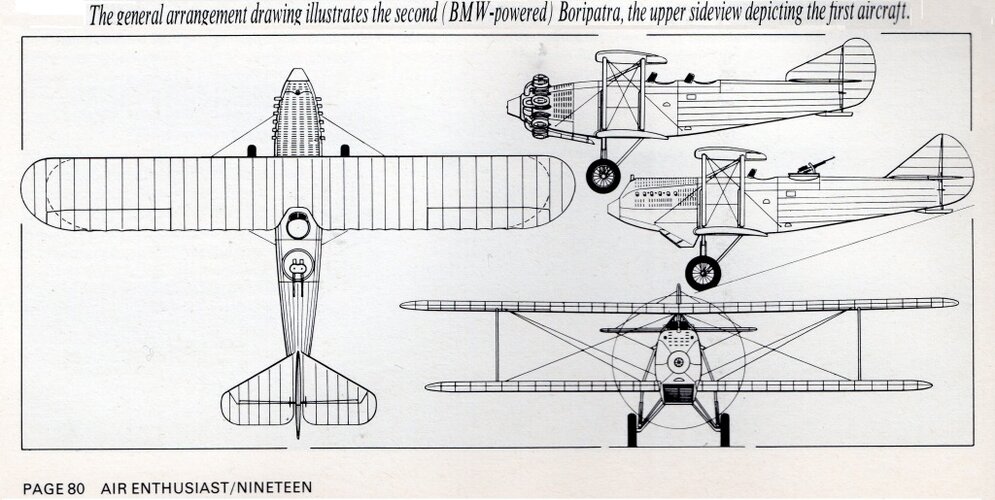- Joined
- 28 January 2008
- Messages
- 635
- Reaction score
- 512
In the early 1920’s the Royal Siamese Aeronautical Service (RSAS) operated licence built Breguet Br.14 aeroplanes powered by 300 hp Renault engines. When Renault increased the price of replacement engines, the head of the RSAS asked the local Siamese Aeronautical Workshop to assess the possibility of a different engine with more power. The Aeronautical Workshop replied that an increase in power could have a damaging effect on the airframe of the elderly French airframe and suggested that it might be better to consider a totally new design.
The head of the RSAS believed this to be an opportunity to develop local experience in aircraft design and experience. Design was to be led by Major Vetchayantarangsarit who was one of the first trained aero engineers in Siam, having undertaken a course in the United States of America. His design was for a conventional two-seat single bay biplane. The wing airfoil section adopted was one studied by the Major while in America. The fuselage was welded steel tube with metal panels covering the forward section and fabric covering to the rear. The upper wing of the biplane had ailerons but no flaps were fitted.
The aircraft was initially designated the Aeronautical Workshop Bomber Type 2. It was fitted with bomb racks and armed with twin Lewis guns mounted of a Scarff ring for the rear gunner.
Work began on 5th April 1927 and the aircraft, fitted with a Jupiter engine, first flew on 23 June 1927. The Bristol Jupiter VI radial engine had a capacity of 450 hp. Appearing a few months later a second example flew with a BMW VI (660 hp) liquid cooled inline engine. This required a redesign to the nose section. Much later an example flew with a Curtiss D-12 (460 hp) engine.
The Bomber Type 2 was renamed Boripatra by King Prachatipok in honour of his brother. Despite the improved performance over the Breguet the type did not replace the Br.14. The type flew on goodwill missions to India and Vietnam.
Five examples were definitely completed with a possible three new examples (or rebuilds) a few years later. The type saw service until replaced by Vought Corsairs in the late 1930’s. It earned itself a place in Thai aviation history as the first aircraft designed and built in Siam (later Thailand).
Incidentally, as part of the Chakri Dynasty bicentennial celebrations in 1982 a three-quarter scale replica of the Boripatra was built and exhibited in Thailand.
Details:
Crew: 2
Engine: 1x Bristol Jupiter VI radial or BMW VI inline or Curtiss D-12
Span: 44 ft 0 in (13.41 m)
Length: 28 ft 9 in (8.76 m)
Loaded weight: 4,070 lb (1,846 kg)
Maximum speed: 157 mph (253 k/ph) - with Jupiter engine
Source:
The aircraft was subject of a 1982 article entitled “A Siamese Experimental” in Air Enthusiast No.19
The head of the RSAS believed this to be an opportunity to develop local experience in aircraft design and experience. Design was to be led by Major Vetchayantarangsarit who was one of the first trained aero engineers in Siam, having undertaken a course in the United States of America. His design was for a conventional two-seat single bay biplane. The wing airfoil section adopted was one studied by the Major while in America. The fuselage was welded steel tube with metal panels covering the forward section and fabric covering to the rear. The upper wing of the biplane had ailerons but no flaps were fitted.
The aircraft was initially designated the Aeronautical Workshop Bomber Type 2. It was fitted with bomb racks and armed with twin Lewis guns mounted of a Scarff ring for the rear gunner.
Work began on 5th April 1927 and the aircraft, fitted with a Jupiter engine, first flew on 23 June 1927. The Bristol Jupiter VI radial engine had a capacity of 450 hp. Appearing a few months later a second example flew with a BMW VI (660 hp) liquid cooled inline engine. This required a redesign to the nose section. Much later an example flew with a Curtiss D-12 (460 hp) engine.
The Bomber Type 2 was renamed Boripatra by King Prachatipok in honour of his brother. Despite the improved performance over the Breguet the type did not replace the Br.14. The type flew on goodwill missions to India and Vietnam.
Five examples were definitely completed with a possible three new examples (or rebuilds) a few years later. The type saw service until replaced by Vought Corsairs in the late 1930’s. It earned itself a place in Thai aviation history as the first aircraft designed and built in Siam (later Thailand).
Incidentally, as part of the Chakri Dynasty bicentennial celebrations in 1982 a three-quarter scale replica of the Boripatra was built and exhibited in Thailand.
Details:
Crew: 2
Engine: 1x Bristol Jupiter VI radial or BMW VI inline or Curtiss D-12
Span: 44 ft 0 in (13.41 m)
Length: 28 ft 9 in (8.76 m)
Loaded weight: 4,070 lb (1,846 kg)
Maximum speed: 157 mph (253 k/ph) - with Jupiter engine
Source:
The aircraft was subject of a 1982 article entitled “A Siamese Experimental” in Air Enthusiast No.19

